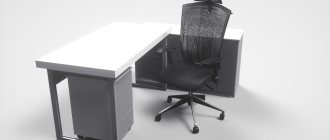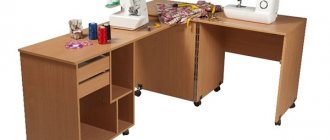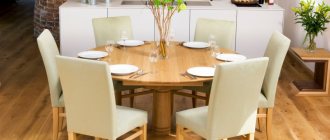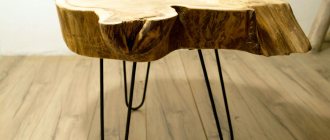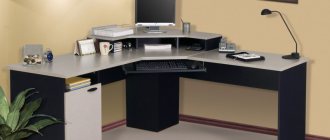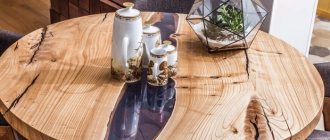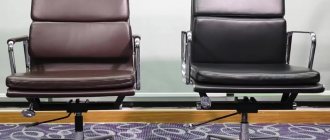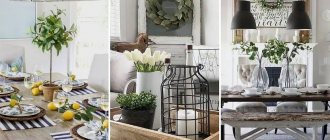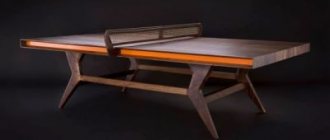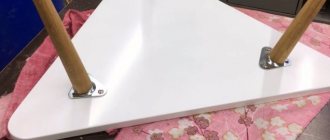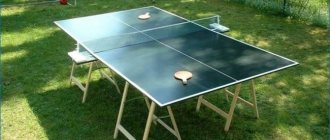Schoolchildren, elderly people, students - in any age and professional category you can find people who cannot imagine their life without a computer. For a comfortable stay at the workplace, they need a comfortable desk. It is not always possible to place all the necessary accessories, fit the tabletop into the interior and select dimensions that match the format of the room.
If you have problems purchasing the right model, you should think about making your own desk for a personal computer. A computer desk top can be simple or complex. There are a huge number of configurations and options. To make this piece of furniture, it is enough to think through the details and strictly follow the instructions.
Table top for computer desk
Types of tables
At first glance, in stores there is a variety of countertops on which you can install home computer equipment. But, on the other hand, all types belong to three: angular, straight, combined with written elements.
To decide on the type of table, you need to consider a number of factors:
- ergonomics;
- operating format – strong, medium or slight (for rare working sessions);
- level of illumination in space, including location according to cardinal directions;
- availability of material, its availability for sale and price.
The variety of types of tables is explained by the difference in functions
Corner tabletop model
When people primarily play at the computer, the angular shape of the tabletop is the most suitable for arranging a work area. For most games, including online and interactive variants, triangular corner tables are suitable.
Table 1. Advantages and disadvantages of a corner countertop
| Pros of a corner countertop | Cons of a corner countertop |
|
|
Corner table for computer equipment Sketch example of a corner table top
Straight table
In fact, this form of tabletop is classic and can serve as a desk. The straight shape is universal. For such a table, you can apply zoning and make it so that it is equally effective to work, play games, and perform multifunctional tasks. Also, to arrange a straight-shaped computer corner, height zoning is used.
For games you can use a straight tabletop model
In general, it is advisable to make a direct model of the tabletop in the following cases:
- The computer is used only occasionally - for viewing emails, searching the Internet, and occasionally playing games online.
- To create computer models, work with graphic information, video files, design, construction - in these cases, there is little distraction from the screen, but at the same time the space makes it possible to relax the eyes.
One of the variations of a straight table
The materials for a straight table will cost 2 times more than for a corner one. Minimal skills are required to obtain the design. This model does not lose popularity in the home-made environment, as it allows you to arrange a work area and additionally equip it with sections for storage.
Table top for combination table
An ideal option that combines the previous two. The only format for working at a desk that does not damage vision when working with text, large amounts of data, and other situations when the user periodically looks at the source code, distracted from working with the screen.
An additional area where the combination table demonstrates its benefits is in graphics.
The disadvantage compared to a straight table is the cost of manufacturing - there will be 30-40% more waste here, since the mixed-type shape requires smooth lines.
Combined designs require more material
To accurately prepare table parts in this configuration, you will need the following equipment:
- electric jigsaw;
- hand router.
A manual milling machine is quite large and expensive to purchase. For a small project, it is advisable to rent such equipment rather than buy it as property. You can also make a table for a router, which makes it much easier to make various parts yourself. Read in detail in a special article on the pages of our website.
Dimensions
Tabletops can have different sizes. They differ in both length and width. It is advisable that the width be slightly larger than the kitchen unit. The optimal tabletop width is at least 800 mm, while the length may vary depending on the number of people for whom the table is intended.
For a small kitchen, a small lid is chosen, and the photos of such a device are beautiful and unusual. If we talk about round models, the smallest tabletop diameter is 75 cm. There are models with a diameter of 160 cm; such a table can accommodate up to 8 people.
For square products, a tabletop measuring 900x900 mm is considered an acceptable option.
Their thickness is also important, usually depending on the production material used. For example, for structures made of laminated chipboard, the optimal thickness is considered to be 3.8 cm, but some manufacturers produce products up to 6 cm thick.
Acrylic sheets are most often presented with a thickness of 12 mm, and this indicator is increased due to the use of additional layers of plywood. Glass surfaces, which are not affected by serious mechanical factors, have a thickness of 8 mm, and if they are used for cooking, then a thickness of 1.6 cm is selected. The depth of the kitchen set products depends on their purpose, since if you plan to install large-sized items, then this indicator must be significant.
Tabletop sizes
Rear cross section of the table top
If the choice fell on a direct or combined option for placing computer equipment, it is necessary to provide a rear cross member that partially covers the structure frame from the rear and ensures its rigidity. The back element is made of any material, including chipboard.
The width of the part should be selected based on a third of the height of the lowest cabinet of the table structure. The minimum width of the part is a fifth of the height of the high cabinet. The thickness of the rear cross member can be any, and the thicker it is, the better the protection of the body from the rear side will be.
If the back of the tabletop is visible, it should look attractive
Before work, it is advisable to saturate the raw materials with a water-polymer composition 60-90 minutes before starting assembly.
Preparing parts
Based on the drawing, parts for the table are cut out of wood or chipboard. Each part is treated with an antipyretic, antiseptic and antifungal compound. Sharp edges are carefully sanded so that there are no nicks, cracks, or cutting surfaces.
Before assembling the furniture, a control measurement of each element is carried out so that they correspond to each other according to the diagram.
Tabletop configurations
The design of a computer desk may vary and, accordingly, different models of tabletops can be used in it:
- modular models - in this case, individual elements are assembled into various design options, so the tabletop must have appropriate fastenings, surface treatment, etc.;
- prefabricated tables - this design also involves the assembly of parts, but in a certain order;
- built-in computer tables - these table models are built into other furniture arrays. There are many options possible here - what material to make the table from, what sketch to make for subsequent work.
Sliding tabletop
There are many variations of different tabletop configurations for computers and laptops. They can combine 2 or even 3 characteristics of these groups.
In the manufacture of countertops, different materials can be used.
Glass models
A material such as glass makes it possible to bring to life an unusual design of work space. In the interior, glass models add weightlessness, thanks to which this furniture will suit any modern interior and furniture, and will also add naturalness and ease.
But there is also a negative side to this design - it is impractical and unsafe. Therefore, when purchasing or making your own glass table for a child, you should think about a different type of material.
Another negative point is that such a fragile model will require careful handling and frequent maintenance due to constant stains on the surface. You should weigh the pros and cons before choosing a glass option.
Ergonomics of working at a desk
Three important points of computer ergonomics:
- You should not place the keyboard low from the tabletop - a difference of 50-70 millimeters from the level of optimal eye contact with the work surface is enough. In addition, 230-350 mm is sufficient. in a side design so that a person can work comfortably behind it.
- The tilt angle to the center of the display ranges from 0 to 20 degrees. For comparison, when writing on a typewriter it is from 40 to 45 degrees.
- The design of the tabletop must be done in such a way that in the final product the elbows do not dangle in space, creating chronic tension. Typists typed while swinging their arms, so they did not have problems with the musculoskeletal system, which cannot be said about those who type at a computer with their arms hanging freely.
Working at a computer desk should be comfortable.
The retractable keyboard panel remains a controversial element that complements the tabletop for working at a PC. Arguments for and against regularly appear among doctors and other specialists responsible for work ergonomics. Currently, computer equipment owners are actively using wireless designs, which greatly simplifies the task. In this case, the keyboard is put aside, control is rarely needed, hard printed sources can also be placed on the table without any problems.
Multifunction devices and scanners
Currently, a block of advanced functionality with the ability to print on a printer, scanner, and copy printing is becoming especially popular. The largest and most expensive ones need to sit on a separate desk or most of a traditional computer desk, so they are not often purchased for home use.
In addition to the computer, the table is designed for additional devices
In residential settings, drum scanners are used, which are professional devices for working with graphics. They also require separate space on the computer desk, but this is not always convenient. As a result, a niche is created in the desk cabinet - this is enough to place a document inside the scanner. The main thing is to make the niche high enough for the scanner lid to move. At home, you can also equip the table structure with a pull-out shelf.
Acoustic devices
When adding additional equipment to a PC system, you should adhere to the layout of the sound system speakers relative to the table.
The acoustic system is placed on shelves
If the listener is near a table, the speaker system is installed at an angle of 90 degrees (in the context of speaker elements). Placement on a corner tabletop is ideal for this.
Acoustics can be placed directly on the table
Preparation of the drawing
When making a diagram yourself on paper, you should display the following parameters:
- Height and depth of the tabletop.
- Frame.
- Location of additional shelves, compartments for equipment, retractable systems for the keyboard.
- The diagram also marks the location of fasteners and metal corners.
An optimally drawn up drawing is the key to a master’s successful work without errors or difficulties.
Note!
- How to make a backlit mirror with your own hands: necessary materials, tools. Tips for choosing lamps and LED strips
- A simple and beautiful DIY bathroom shelf made of MDF, glass, plasterboard: straight and corner options. Photo instructions, tips, video master class
- Do-it-yourself folding table: description of types, calculations and selection of tools and materials. Video master class for beginners
What to make a computer desk from
laminated chipboard
The material for the countertop is usually laminated chipboard. It is most convenient for the manufacture of cabinet furniture. Laminated chipboard is easy to process, it is simply attached and does not require special skills to connect parts. You can find the necessary fittings for such slabs on sale at any time.
Table 2. Advantages and disadvantages of laminated boards
| Advantages | Flaws |
| 1. Wear resistance. 2. Resistant to sunlight. 3. Easy care, availability of a variety of cleaning products. 4. Availability of different colors and patterns. | If moisture constantly enters the area of the countertop, the material may swell. |
Laminated chipboard is suitable for simple countertops and complex options
MDF
According to the characteristics, the MDF tabletop will resemble the previous version. The difference is that it is less brittle and is not prone to delamination in fastener areas. If you do not take into account the need to handle laminated chipboard more carefully compared to MDF, then these materials are almost identical during assembly and during the preparation (processing) process.
Table 3. Pros and cons of MDF when making countertops
| Advantages | Flaws |
| 1. Safety – suitable even for children. 2. Variety of colors. 3. You can make a window sill-tabletop from MDF. 4. Variety of sizes of the final tabletop model. | 1. Damages that appear during use are clearly visible on a glossy board. 2. It is easy enough to damage the slab so that a visible mark remains on it. 3. Constant contact with water leads to swelling of the slab. |
Tabletop combined with window sill
Metal
Sometimes metal or individual elements with a metal base are used as the base for the countertop. The most common option is to use a metal frame to place a tabletop with work surfaces made from the sheet materials indicated above (this can be sheets of chipboard, laminated chipboard, pieces of plywood, etc.). The frame is made of round steel pipes or rectangular pipes. Processing options: chrome-plated or simple metal elements (the latter need painting).
Metal is used to create computer desks
To make metal countertops, you will need some skills in working with such parts and the availability of the appropriate tools.
Despite the fact that working with metal is not so easy (in particular, stainless steel), it also has its advantages.
Table 4. Advantages and disadvantages of metal as a base
| Advantages | Flaws |
| 1. No damage to the material upon contact with water. 2. Large and wide models are made without joints, which in itself prevents the structure from being vulnerable during intensive use. 3. The practicality of the material is its undeniable advantage. | You need to carefully consider the development of the sketch, since it is almost impossible to select a metal table of the required size in a store. |
Metal table top
Tree
Working with wood when making a countertop is not the most labor-intensive, but it requires more consumables, tools and fittings.
At the same time, to make a wooden table, such types of work as cutting, sanding, planing, and also intermediate operations are performed. If you choose an array for the base of the countertop, you need to be especially careful not to spoil the expensive material.
Woodworking is often carried out in a specialized workshop
Table 5. Advantages and disadvantages of wood as a base
| Advantages | Flaws |
| 1. Combinations with any other materials are available. 2. Allergic reactions upon contact with the countertop are excluded. 3. A wooden PC tabletop will fit into any interior. 4. Long service life of the computer desk, resistance to wear and mechanical stress. | 1. High cost of material. 2. Despite the fact that the material is dense, it will require protection from mechanical and temperature influences. |
Recommendations for selection
I will go over the important points that you should consider when purchasing.
| Illustration | Description |
Design dimensions. There are several important parameters here:
| |
Color and stylistic execution.
| |
| Manufacturer. It makes no sense to list specific brands, since in each region there are both large and small companies offering desks. You can read reviews about this or that furniture on specialized resources on the Internet. Also ask the opinion of those who already use similar products, if there are any in your environment. | |
Installation location and availability of free space.
| |
| Execution type. Most often, standard furniture is used, which is a complete product that can be carried and transported. But if you wish, you can order an option that hangs on the wall or replaces the window sill, as in the picture. Such solutions are good because they fit perfectly into your space. But it is impossible to move them to another place. |
If you have an old wooden table, then you can update it yourself. First, the surface is sanded to remove damage and make it smooth. Then the damaged areas are puttied and painted.
How to make a computer desk at home
Ergonomics, quality of material, reliability of fittings – requirements are imposed on any furniture based on its purpose. The work area always involves increased load and quite a lot of wear and tear. Therefore, when creating a sketch, you need to consider how the parts will be attached, how strong the table will be, and so on.
Tabletop fastenings may vary
Sketch development
A sketch is needed to fully determine the assembly order, quantity and types of base material for the countertop, design and configuration.
Procedure for developing a diagram:
- first determine the style - it is important that the size and shape of the tabletop fit into the interior and dimensions of the room;
- Next, the color, material, and other individual characteristics of the model are determined;
- If you have no experience, you can use a ready-made drawing, or take a diagram from design programs as a basis. The advantage of ready-made packages is the accuracy of calculations (dimensions, markings for the frame, fittings and other important assembly components).
Prepare a sketch of the tabletop
If the tabletop is connected to a special niche in which excess wires will be hidden, you will have to think about through holes in advance. They will help maintain order in the workplace.
The simplest PC desk should match the decor of your living space
Dimensions
When making calculations, you need to pay attention to the length and width of the tabletop.
The length should not be too short or too long, and in general it is recommended to follow the rules:
- The space for the owner should be approximately 60-70 cm.
- The rotating part of the tabletop is approximately 55-60 cm.
The average size of corner computer tabletops is 160-170 centimeters; for a compact PC placement, 130 cm is sufficient. The straight model goes well with a length of 100 cm or more.
Additional details affect the dimensions
The depth of the countertop is determined by a fairly simple method:
- The worktop without extensions must be constructed with a minimum depth of 45 cm.
- If there are extensions, the depth of the tabletop should be from 60 to 70 cm.
- Tabletops in designs with drawers have a depth of at least 65 cm.
- For corner countertops with lower shelves, the depth is calculated to be at least 85 cm.
Standard dimensions of a straight tabletop
What you will need
Before you go to buy a tool, you need to decide on the base material - this determines how much and what quality it will be needed. If we talk about the basic set for work, it includes:
- Tape measure, square, ruler for measurements.
- Pliers.
- Hammer.
- Awl.
- Screwdriver.
If you plan to make a countertop from laminated chipboard or LMDF sheets, the following tools will be useful:
- Iron for joining edges.
- Drill bit for installing door hinges.
- Screwdriver (using nails and a hammer is not always possible, but screws form a stronger and more reliable structure).
Tools for creating a tabletop are varied.
A metal tabletop frame requires:
- Bulgarians.
- Electric drills.
- File.
- Sandpaper.
Additionally, materials may be required that will give the final product an original look.
The final appearance of the table can be supplemented during the assembly stage
General operating procedure
You can imagine assembling a tabletop as a sequence of actions:
- production of table components;
- preparatory work – processing of parts;
- combining structural elements.
A table made of laminated chipboard is quite rigid in itself and does not require a frame. To make a tabletop, you need to do the following:
- cut slab parts according to specifications;
- process the edges of the resulting parts, for which they use thin materials on which an adhesive layer is pre-applied, or thick ones with a special edge;
- Various methods are used to assemble parts - confirmat, ties, screws, corners, etc.
Material processing
If the tabletop structure contains metal elements, welding work may be required in a prepared room or outdoors. If you don't have a welding machine at hand, you can use bolts. It should be remembered that in this case the connection will not be as neat and compact as with welding seams. An exception is the use of chrome-plated tubes, when the assembly is initially carried out using bolts and connecting elements.
Working with metal is complicated by the presence of welding joints
Working with solid wood to produce a solid table requires special equipment and manipulation of machines located in specialized workshops. Wooden parts are processed with a lot of dust and debris, so it is better to carry out final finishing and assembly at home, entrusting the preliminary work to professionals.
Choosing a place for the table
A desk that is too large will make it difficult to move around the room, while a desk that is too small may not be functional enough for everyday tasks. Therefore, when designing a tabletop, this point should be taken into account.
The following requirements must be met:
- presence of a grounded socket;
- the absence of heating devices near the table - batteries, fireplaces, electric heaters, so that the computer does not become unusable due to unacceptable temperature conditions of operation;
- decorative elements, shelves and pictures should be removed so as not to interfere with the placement of additional elements above the tabletop.
Simple corner table
The simplest corner option will not require the future owner to have any special design skills or work with various materials.
Stage 1. In order to construct a simple corner tabletop, the materials you will need are:
- standard chipboard or laminated chipboard, as well as laminate – 1 piece;
- about 2.5 m. C-shaped edging (PVC profile);
- fastener
Drawing for cutting and fastening the tabletop
The T-shaped edge can only be taken if a special tool will be used for the work.
To mark the parts of the table you will need chalk or a marker. They can also be useful during assembly. The ideal option for work is washable markers.
Stage 2.
After cutting the base material, the table is assembled.
We fasten the tabletop with corners to the wall. Schemes for fastening the corner part.
The advantage of this method is the rational use of raw materials. The trimmings will close the gap in the corner, and will also become the basis for shelves - for a printing device (1st) and a speaker system (2nd). A general idea of the assembly can be seen in the photo. The fasteners in the green circles are self-tapping screws that are screwed into the slots using washers. The red part refers to the support for the far corner of the tabletop. In this case, the self-tapping screw is located obliquely and upward in the wall.
The cuts in the process of working with the material may be sloppy - in this case, they are either covered with a finishing edging, or left in their original form, when this is acceptable from an aesthetic point of view.
Despite the simplicity of the design, a computer tabletop made according to these instructions can withstand up to 80 kg. weight. An additional advantage of the table is its compactness and ability to take up minimal space in the room. If a system unit is supposed to be placed under the table, you need to equip furniture corners for it. To prevent it from tipping over, you can add a stopper made from a piece of plastic box to the structure.
The finished structure can be supplemented with shelves
A corner shelf in a room is an excellent solution that will not allow a single centimeter of free space to go unused. Find instructions for making shelves in a special article.
Video - DIY computer desk
Video - Do-it-yourself table or purchased one?
Video - Do-it-yourself computer desk from chipboard scraps
Peculiarities
This type of furniture has a number of important differences from other options:
- The table is designed for work . Therefore, maximum attention is paid to its convenience. If you are uncomfortable, you will get tired very quickly. Therefore, select a specific solution taking into account your anthropometric data and usage characteristics.
- The structure must have certain dimensions . For a desk, the minimum depth is 60 cm and the minimum width is 100 cm, preferably 120 cm or even more.
- If you are going to place the computer on a desk, then the depth should be even greater - about 80 cm . And in the lower part there is usually a compartment for the system unit and a roll-out shelf for the keyboard, so as not to take up useful space on the table.
After installing the monitor, there should be enough space on the table to do written work
- Choose high-quality and durable materials . With active use, the surface quickly wears out. In addition, there are increased requirements for reliability, since the furniture is usually used for quite a long time.
- Appearance is also of great importance . If furniture is selected for an office where negotiations will be held or agreements will be concluded, then solid wooden options are chosen. If you are just choosing a table, then you should make sure that it fits organically into the surrounding environment.
Varieties
Today there are many models of desks with different types of tabletops on the market:
- Roll-out. They are functional and save space. These models are ideal for small rooms. They are not stable, so they are not suitable for children or for constant use. The models fit very well for the computer.
- Retractable. Used primarily as an additional workplace, they are comfortable and functional. Due to the fact that the tabletop can be retracted when not needed, such products are very popular among consumers. Suitable for working at the computer, for children and adults. For frequent use, it is still better to choose a more thorough model.
- Folding. Models with such a working surface are in great demand. The structure is fixed on the wall. If necessary, the tabletop is folded back, supported by supports, and then you can work. The models are suitable for both adults and children. They are good for sitting at the computer, but as a permanent place to work with papers they may be uncomfortable.
- With an inclined surface. Such tables are ideal for children and are analogous to a school desk. They are convenient for learning, reading, writing. These products are also suitable for adults to work with papers. But tables may not be comfortable for sitting at a computer.
- Models with a rotating tabletop on wheels. Convenient and mobile, they can be moved between rooms if necessary. Such products are more suitable for use by adults, working with papers and at the computer.
The table top-window sill saves space and looks very stylish. It is suitable for working at the computer (for children and adults) and more. At the same time, the obvious advantage of this model is the presence of natural light from the window.
Roll-out Retractable Folding With an inclined surface With a rotating tabletop
Metal options
They are most often used in high-tech and loft styles, combining perfectly with decorative brickwork and the overall interior.
The structures are durable, not subject to corrosion and deformation. In addition, they have a pleasant design with an elegant cool shine.
Our carpentry production
Our company has existed for more than 5 years. During this time, we completed orders for 18,000 customers. Our own production allows us to provide a full range of services with wood products. The production is equipped with modern equipment, which allows us to strictly adhere to the technological process and produce products with millimeter precision. Each stage of production is controlled by professionals.
We produce from 500 products per month according to individual customer sizes
We have completed orders for 18,000 customers from Russia, the CIS and Europe
Full range of services and wide production capabilities
A 5-stage product control system has been organized at the production site
Linear options
The entire structure is located in one row along one wall. Differences of the linear model:
- Rectangular tabletop shape.
- The presence of many drawers.
- Convenient cutout in the tabletop for the user.
This version of the desk is a classic and the most common model.
Tags
Tables Table top for a comfortable table. fit a table top into for a computer table for a computer table make a computer table make a computer table top home computer equipment. for computer equipment arranging a computer corner with your own hands with your own hands with your own hands with your own hands or what to make a computer How to make a computer room and make it you can make a table top to make a computer How to make a computer to make use how to make a computer
pricesprojectkitchenrollershomeinstructionsholesratingsadd palletssourcedesk
Table equipped with an extension
This option is more suitable for people of average and tall height. It is comfortable to work at the monitor while sitting in a large chair. The system unit with wires is placed below in the legs, which are made from old book shelves. The LCD screen is placed on stainless steel supports, slightly above the tabletop. The product is additionally equipped with LED lighting, which gives it a futuristic look.
Simple accessory with shelf
A simple, ergonomic option with sectors measuring 0.5 by 1 m. It is made from planed wood or improvised materials (old furniture, pallets). For manufacturing you will need a circular saw, a chisel, an angle grinder and other small tools.
Backlit
High-quality lighting will be the highlight of any design. Furniture equipped with an LED strip appears to float in the air, creating a feeling of lightness. The accessory will fit perfectly and decorate a small room.
The advantages of making furniture with your own hands
Of course, in order to make any pieces of furniture yourself, even the simplest ones, you need to be able to work with carpentry tools. It is quite simple to acquire this skill - it is recommended to train on simple and miniature products (for example, a shelf for a hallway or a coffee table), and only then move on to larger ones. A desk is one of the simplest designs, because many people prefer to choose basic options without additional elements in the form of shelves, a cabinet or a footrest.
The main advantages of self-manufacturing structures include:
- cost savings;
- you can choose the best quality materials;
- creating your own unique design;
- the ability to take into account the features of the room layout.
If you already have experience in making furniture, then you can create a more complex design.
Another advantage to the “protection” of making furniture yourself is the opportunity to realize your creative potential. In addition, such work can be done step by step, slowly and even enjoying, while following all the instructions and manufacturing technology.
Sketches of corner products
Below are assembly diagrams for the most popular models. Making such interior items yourself will not be particularly difficult.
Required materials and tools
Before you make a simple table from boards, you need to prepare:
- Angles;
- Varnish, paint or stain;
- Screws;
- Roller;
- Jigsaw or saw;
- Grinder with a grinding wheel or sandpaper;
- Screwdriver;
- Wooden elements: board for table top, legs.
Homemade corner table
When no store-bought model suits you, or you don’t have the necessary budget, then the best option would be to create an accessory yourself. You don’t need any special skills for this, just learn how to drill, grind, saw and have good patience. Photos with step-by-step instructions and drawings of computer desks with dimensions of parts will facilitate the manufacturing process.
